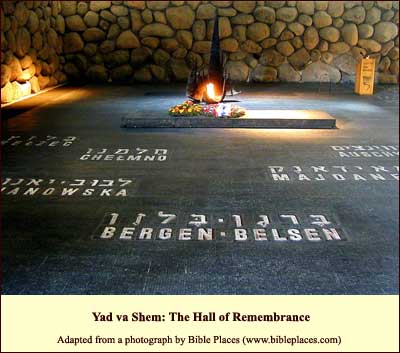Yad Va Shem: the Holocaust Memorial
Even the word "Holocaust" ("whole burnt offering") has become such a well-worn, slippery token -- a piece of old currency used to cover new debts -- it can give its users the illusion that they know what they are talking about, when they have long ceased to feel the reality it was coined to represent. To grasp that reality is a problem. One tends to start with numbers: eleven million dead in the camps and ghettoes, of whom six million were Jews, of whom one and a half million were children. Each day of the year 1944, the Nazis murdered ten thousand Jews. Suppose the events of September 11, 2001 happened twice every day for an entire year? Double that and you have the number of Jews. Double it again, almost, and you have the total number.
The figures roll trippingly off the tongue: eleven million, six million, one and a half. But there is something unreal about this bandying about of numbers. When we speak of people in quantities, we lose sight of their humanity: that in each case these are human beings, bound to each other as we are bound to those we love.
By spewing out numbers, then, we cannot grasp the event. It cannot make a difference.
So what do we do? We read individual accounts: Anne Frank's, Elie Wiesel's, Primo Levi's, Corrie Ten Boom's. Then we can feel what it felt like to live this event. Inevitably, though, we lose sight of the massiveness -- and that massiveness is an undeniable aspect.
This, then, is the problem with the Holocaust: it was massive almost beyond comprehension, yet in each case these were particular lives like ours. In order that this event may make a difference, we must be able to grasp the massiveness without losing sight of the particularity.
The Children's Memorial at Yad Va Shem is an attempt to do this. The designer (Moshe Safdie) used candles, darkness and mirrors.
The main museum presents documents and photographs. It is a good idea to visit it first, if possible, in order to have the material freshly in mind when one goes through the Children's Memorial.

There is much else too: The Hall of Remembrance, a place of reflection and ceremony The Pillar of Heroism, remembering those who resisted the Nazis The Garden of the Righteous Gentiles. Each tree represents a non-Jew who risked his or her life, and the lives of family members, in order to rescue Jews. The trees were planted, when possible, by the rescuers themselves. An art museum, containing works that attempt to come to grips with these events. The Hall of Names, which records and keeps the names of the victims. (It closes earlier than the rest of the site.) The Valley of the Communities. Embedded in the southern slope of the hill, this is a mazelike structure, modeled on a gutted quarry. In the stones are incised the names of the destroyed Jewish communities.
Yad Va Shem maintains its own Web site Please go to the following link for logistics: Logistics for a visit